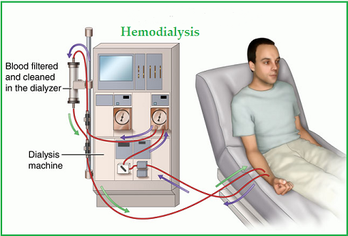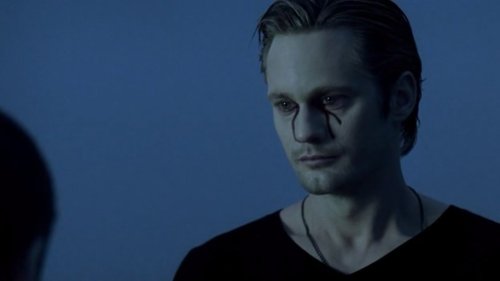

Historical Tales | News | Vampires | Zombies | Werewolves
Virtual Academy | Weapons | Links | Forum
 |
 |
Historical Tales | News | Vampires | Zombies | Werewolves Virtual Academy | Weapons | Links | Forum |
I have some questions about vampires. The first is, what happens if a human has astigmatism or myopia and turns into a vampire? I understand that all vampires are extrimely susceptible to light, but I'd like to know if certain eyesight conditions change or get altered after the transformation. The second question is, what happens to an existing and persisting virus in the human body (like HIV or human papilloma virus) if one is tranformed into a vampire? Do these humans die or are the viruses somehow neutralized by the human vampiric virus? If I'm correct, vampire cells commit mass suicide when they're overcrowed — does this apply to warts?
![]() —Hector Salgado , Nuevo León, México
—Hector Salgado , Nuevo León, México
 |
| Would a vampire benefit from eyeglasses? |
Since HIV came about after the FVZA was disbanded, there isn't any reliable documentation on how vampirism interacts with it. However, it's theorized that victims with full-blown AIDS would be much more vulnerable to dying during the coma stage, as it makes way for many opportunistic infections. It's also unknown how the vampirism virus would interact with cellular DNA rewritten by HIV, possibly resulting in a vampire with a very poor or overactive immune system, or cells that constantly produce faulty, lethal copies of the vampirism virus. The possibilities are numerous. As for other viruses, a general rule of thumb is that the victim will have a harder time surviving the coma, but if they do complete the transformation then their previous infections are effectively eradicated or forced into dormancy, since those viruses can only replicate using human cells (although the possibility of viral mutation is quite real).
Vampiric apoptosis typically only takes place with "soft" growths -- ones that have not yet become tough and fibrous like warts. Even cancerous tumors aren't completely eradicated, but simply shrunken to the point they no longer cause harm to the surrounding tissues, leaving only a clump of fibrous scarring. Basically, if a healthy human's immune system can't possibly get rid of something on its own (like warts or scars), then neither can a vampire. The latter just does it at a more efficient and accelerated rate.
![]() —Robert Lomax, FVZA
—Robert Lomax, FVZA
What kinds of cars do vampires drive?
![]() —ShogunDarH, Ottawa, Ontario, Canada
—ShogunDarH, Ottawa, Ontario, Canada
 |
| A vampire in today's world might drive something along the lines of a Chrysler 300 |
A: First off, it's true: Vampires drive motor vehicles, according to Dr. Pecos, and they have since the very beginnings of automotive transportation. Their excellent reflexes and powerful night vision make them highly capable of driving after dark. As they do with most of their decisions, vampires focus on discretion when choosing automobiles. Many could easily afford to drive Maybachs, Rolls Royces or Ferraris, but they know better than to motor around in such auspiciously high-end vehicles. Remember: They don't want to attract attention. Think of what an affluent retiree in Naples, Florida, or Scottsdale, Arizona, would drive and you'll get an idea of a vampire's ideal car or SUV. They tend to gravitate toward mid-range Lexus sedans, Toyota Avalons, Chrysler 300s, BMW 5 series sedans and C class Mercedes four-doors. A vampire in a car will be virtually indistinguishable from an elderly person; in other words, not the type of driver that would draw the interest of the police.
As seen in the movie "Near Dark," a pack of vampires will use RVs, but sparingly, They will seal off the living quarters of the RV from light, and use a driver to get them from place to place. Packs will also use box trucks and vans when relocating to a new base. There have even been scenarios where vampires have operated 18-wheelers, as in the "Terror on the Interstate" case of 1967.
 |
A Pierce Arrow limousine similar to the |
In the past, older, wealthier vampires often owned limousines or town cars and employed the services of a driver to spirit them around. A rich vampire by the name of Bluford Magee actually played a peripheral role in automotive history, according to Dr. Pecos' case files. Back in the 1920s, Magee lived in a gated Victorian mansion shrouded by large trees on Adams Ave. near downtown Memphis, Tenn. He was from old money — very old money, as it turned out he was a former slaveholder who had been alive for almost 200 years. Magee liked expensive cars, and his favorite was the Pierce Arrow limousine. Back then, cars could be customized at the factory to meet the needs of wealthy clients. Magee asked the engineers at Pierce Arrow if they could make the windows of the limo's passenger compartment block out the sun, as he claimed he had a "congenital sensitivity" to sunlight. He made it clear that no price was too high. Engineers at the company worked on a number of different solutions before developing a tinted glass that would do the job. Unknowingly, the engineers had made it easier for Magee to extend his nightly forays into the city in search of fresh blood. But Magee's devotion to his ostentatious car proved to be his undoing, as witnesses linked the car with several mysterious disappearances in the city. The FVZA traced the car to Magee and put a tail on him one night as his driver took him out in search of a feeding. A chase ensued, and Magee's driver lost control of the big auto and crashed it into a ditch. Magee fled and was on the run for several days. Eventually a farmer flushed him from a barn and into the sunlight, where he died an agonizing death. Though Magee was gone, the technological advances made on his Pierce Arrow live on in the window tinting of today's cars.
![]() —Richard Dargan, FVZA
—Richard Dargan, FVZA
 |
| The relationship between humans and vampires is a bit like that between a dialysis machine and a patient. |
A: It's not so much specific proteins as much as the unique concoction of numerous substances that make up human blood. If it was as simple as a few proteins, those could easily be replicated and mixed with animal blood or some other substitute in lieu of a vampire's natural prey. The fact that the FVZA was shut down didn't help matters, either. Lots of valuable research was either cut short or taken over by less transparent organizations. For instance, even though it's almost 2020, we still don't have a (known) vaccine for lycanthropy.
Vampires feed on humans because they too are human to a degree. Think of humans as being living dialysis machines, absorbing all the different varieties of food we consume, digest, filter and add to our own blood for continued survival. Vampires, being incapable of eating most foods, are forced to prey on humans to take what they cannot make themselves. Non-human mammals metabolize food using similar mechanics, but their blood chemistry is just too different to offer long-term sustenance. Trying to correct that is about as likely as making all blood types safe for everyone.
![]() — Robert Lomax, FVZA
— Robert Lomax, FVZA
What do vampires and zombies sound like?
— Dale, Dothan, Alabama
Vampires and zombies sound different from humans, and the differences become more pronounced over time.
 |
| The Black Book |
Let’s start with zombies. Early-stage zombies sound somewhat similar to their human selves. They try to form words and sentences. and they can vary the pitch and volume of their voice. However, they are unable to speak clearly because of degradation in the language centers of their brains (imagine a drunk person—a very drunk person—trying to speak). They may growl, hiss and even shriek to express their emotions. As time passes, their vocal chords deteriorate and they begin to emit some truly horrible noises—nothing like the steady groan of movie zombies. Mid-stage zombies will wheeze and gurgle due to excess fluid in their lungs. Later, as that fluid dries up, zombies will emit a chilling, guttural sound we used to refer to as “the zombie rattle.”
A quick aside: I never once, in all my years of zombie hunting, heard a zombie say “brains!”
In contrast to zombies, vampires retain the ability to speak, although their voices change significantly as the years pass and their mucous membranes thin and they lose elasticity in their vocal chords. A male vampire will develop a higher, thinner-sounding voice, while a female vampire’s voice will deepen. Structural changes in the voice box also cause vampires to speak more quietly. When they try to shout, their voices crack. They prefer to hiss, expelling air through their clenched mouths.
On a side note, it is true, as many movies and books have suggested, that vampires have their own language. It is a variation of Latin known as Bursan that was thought to have originated in Burs, an area of present-day Romania. Not all vampires bothered to learn Bursan, but the more disciplined groups made it mandatory for any new members. The oldest surviving Bursan text was found in the remains of a Viking camp near present-day Wexford on the southeast coast of Ireland. It is known as the Black Book, not because it is black but because the Vikings were sometimes referred to by the Irish as the “dark invaders.” It is not known how the book came to be in the possession of the Vikings. The Black Book currently resides in Trinity College, Dublin.
Do vampires really cry tears of blood like the vampires in True Blood?
— Sheldon, Lawrence, Kansas

The notion that vampires cry tears of blood has been around for awhile; long before True Blood.
Vampire eyes are different from those of humans in several key ways. They are adapted for night vision, with dilated pupils that allow in more light. This is why a vampire appears to have black eyes. Another difference is that vampires typically have red, inflamed sclera—the so-called "whites of their eyes." Because of this, people throughout history have come to believe that vampires have bleeding eyes. But the blood is confined to the eyeball and does not flow out like tears.
On a related note, some of you have asked me about this video of a young man in Tennessee who bleeds from his eyes and whether this indicates vampirism.
The blood coming from the young man appears to be originating from the tissues around his eyes. If he actually were a vampire, his pupils would be enlarged, the whites of his eyes would be red and—most notably—he would have sharp, pointed canines. In addition, he would be unable to tolerate sunlight. I sincerely hope his condition is diagnosed and cured, but fortunately, he is no vampire.
There are several variables that affect the speed of a zombie outbreak, including:
 Zombies can be described as "vectors," or organisms that carry and transmit a disease. Elderly people confined to beds or wheelchairs would be classified as terminal vectors, because even if they awaken from a zombie coma, the chances of them spreading the virus are minimal. So while an outbreak might spread quickly through a nursing home, it would present only a small risk to the surrounding community. In contrast, a young, reasonably fit person is a primary vector and would be extremely dangerous when awakened from a zombie coma. For this reason, you can see why a zombie virus outbreak on a college campus would have a greater likelihood of spreading into the surrounding community.
Zombies can be described as "vectors," or organisms that carry and transmit a disease. Elderly people confined to beds or wheelchairs would be classified as terminal vectors, because even if they awaken from a zombie coma, the chances of them spreading the virus are minimal. So while an outbreak might spread quickly through a nursing home, it would present only a small risk to the surrounding community. In contrast, a young, reasonably fit person is a primary vector and would be extremely dangerous when awakened from a zombie coma. For this reason, you can see why a zombie virus outbreak on a college campus would have a greater likelihood of spreading into the surrounding community.Even with the risk of traffic jams, your best protection against a zombie outbreak is a gassed-up vehicle. Have an escape route in mind. Often times, side streets are better than gridlock spots like the Hollywood Freeway in Los Angeles or the Capital Beltway in Washington, D.C.
Keep a "bug out" bag (like the one pictured above right) on hand stocked with essential supplies like food, water, matches, etc. Your kit should contain enough provisions to keep you safe for up to two weeks. This means you'll have to have access to a water supply and a means with which to purify it. Keep a battery-operated radio for communication with the outside world. Be sure to update your bag to account for the change of seasons; i.e., more water in the heat of summer, more clothing/blankets in the dead of winter.
Watch the news for any unusual stories about people with viral infections, like flesh-eating bacteria or rabies. The media will often misreport zombie outbreaks in their early stages.
Take steps to be prepared, but don't let anxiety about a zombie outbreak put a cloud over your head. An outbreak is unlikely, and even if one was to occur, it would probably be over within a week or two.